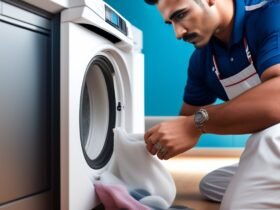Is your washing machine acting up again? Don’t fret; we’ve got you covered. In this comprehensive guide, we’ll walk you through everything you need to know about washing machine repair, from identifying common problems to executing DIY fixes like a pro.
Understanding Common Washing Machine Problems
Identifying Leakage Issues
Leaky washing machines can be a real hassle, causing water damage and potential safety hazards. If you notice water pooling around your appliance, it’s crucial to pinpoint the source of the leak promptly.
Diagnosing Electrical Malfunctions
Electrical glitches can disrupt your washing machine’s performance, leading to issues like failure to start or incomplete cycles. Understanding how to troubleshoot electrical components can save you both time and money on repairs.
Addressing Agitation Problems
Is your washing machine refusing to agitate properly? Learning how to diagnose and address agitation issues is key to restoring your appliance’s functionality.
Tackling Drainage Concerns
A clogged drain pump or faulty drainage system can leave your clothes soaking wet and your washing machine inoperable. Knowing how to troubleshoot drainage problems is essential for maintaining smooth laundry routines.
Essential Tools for DIY Washing Machine Repair
Screwdriver Set
A versatile screwdriver set is a must-have for disassembling washing machine panels and accessing internal components with ease.
Multimeter
A multimeter allows you to test electrical circuits, switches, and other components for continuity and voltage, aiding in the diagnosis of electrical malfunctions.
Pliers and Wrenches
Pliers and wrenches come in handy for tightening loose fittings, removing stubborn bolts, and manipulating hoses during repair tasks.
Safety Precautions Before Repairing
Unplug the Appliance
Before performing any repairs, always disconnect your washing machine from the power source to prevent electrical accidents.
Wear Protective Gear
Protect your hands and eyes by wearing gloves and safety goggles while handling sharp edges and electrical components.
Turn Off Water Supply
To avoid flooding or water damage, shut off the water supply to your washing machine before conducting any repair work.
Step-by-Step Washing Machine Repair Guide
Inspecting the Hoses
Check for signs of wear or damage on the hoses connecting your washing machine to the water supply, as leaks or cracks can lead to water leakage.
Checking the Door Seal
Inspect the door seal for tears, mold, or debris buildup, as damaged seals can cause water leaks and affect the appliance’s performance.
Testing the Water Inlet Valve
Test the water inlet valve for continuity using a multimeter to ensure proper water flow into the washing machine during cycles.
Examining the Drain Pump
Remove the drain pump and inspect it for clogs or debris that may be obstructing water drainage, causing the appliance to malfunction.
Tips for Extending the Lifespan of Your Washing Machine
Regular Maintenance Routine
Schedule regular maintenance tasks such as cleaning the drum, checking hoses, and inspecting seals to keep your washing machine running smoothly.
Use High-Quality Detergents
Choose high-quality detergents and fabric softeners to minimize residue buildup and maintain optimal performance and cleanliness in your washing machine.








Leave a Reply